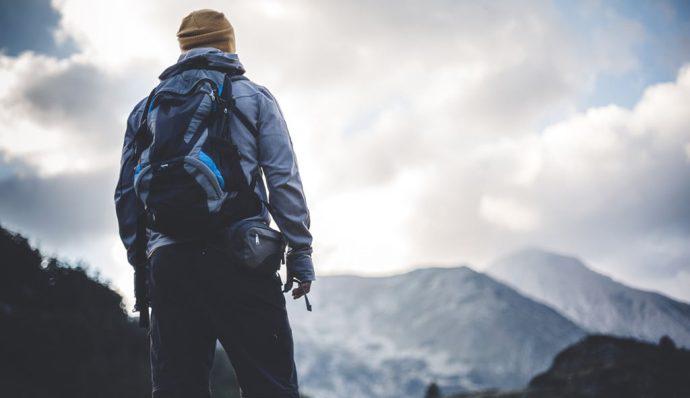How to Layer When Hiking
When hiking, layering is a great way to stay comfortable and safe in varying weather conditions. Start with a base layer such as long underwear or leggings made of moisture-wicking fabric that will keep you warm and dry. A mid-layer such as a fleece can then be added for extra warmth if needed.
The outermost layer should provide protection against wind and rain, such as a waterproof shell jacket or windbreaker. Finally, add accessories like gloves, hats, scarves, gaiters, etc., depending on the temperature outside. Make sure your layers are lightweight but also provide adequate insulation so you don’t overheat when temperatures rise during the day or become too cold at night.
Layering helps regulate body temperature while keeping you protected from the elements!
- Step 1: Dress in Layers – The key to successful layering when hiking is wearing multiple layers of clothing
- Start with a thin, moisture-wicking base layer such as a tank top or long-sleeve shirt, then add an insulating mid layer like fleece or wool and finally a waterproof outer shell for protection from the elements
- Step 2: Adjust Layers as Needed – When hiking you should be aware of your body temperature and adjust your layers accordingly
- If you start to get too warm remove some layers and tie them around your waist so that they are accessible if needed later on
- Step 3: Wear Proper Head Protection – To ensure that you stay comfortable while hiking it is important to wear proper head protection such as a hat or beanie
- This will help keep your head warm in cold temperatures and protect it from the sun in warmer climates
- Additionally, make sure to bring along sunglasses or goggles for eye protection against UV rays and debris kicked up by other hikers on the trail
- Step 4: Protect Your Hands – Keeping your hands protected is essential when layering for hikes; whether cold weather requires gloves/mittens or hot weather calls for light fingerless gloves, having something between your skin and any rocks/branches you might grab onto can save painful scrapes!

Credit: www.onestepthenanother.com
What is the 3-Layer Rule for Hiking?
The 3-layer rule for hiking is one of the most important concepts to understand when it comes to taking on a challenging outdoor adventure. This rule states that you should always wear three distinct layers of clothing while out on a hike, in order to ensure optimal performance and comfort. The first layer consists of your base layer, which helps keep your body warm by trapping heat close to the skin and wicking away sweat.
The second layer is an insulating mid-layer such as a fleece or wool sweater that provides extra warmth during colder temperatures. Finally, the third layer is usually a waterproof and windproof jacket made from fabrics like Gore-Tex or nylon that protect you from light precipitation and wind chill. Layering with these items will help you regulate your core temperature no matter what sort of weather you may experience when exploring the outdoors!
How Do You Layer Up for Hiking?
When it comes to layering up for a hike, you want to make sure that you have the right pieces in place to make your journey comfortable and safe. First of all, start with breathable base layers – such as a long-sleeve top and leggings – made from merino wool or synthetic fabrics like polyester or nylon. These will keep sweat away from your skin while also providing insulation against the cold.
Then add a mid-layer such as a fleece jacket or light insulated jacket over the top; this will provide additional warmth but still be lightweight enough so that you don’t become too hot when walking uphill. Finally, finish off with an outer layer like a waterproof raincoat or windbreaker; this should protect you from any rain showers and help block out chilly winds on exposed ridges during colder days. Don’t forget about accessories either – gloves, hats, scarves, etc can really help improve comfort levels on hikes!
Why Do Hikers Wear Layered Clothing?
When it comes to outdoor activities like hiking, one of the most important things a person can do is dress appropriately. Layering clothing is an important part of this process, as it helps hikers stay warm in cold temperatures and cool when it’s hot outside. Wearing multiple layers also provides protection against wind and rain, which can be especially helpful if you plan on spending extended periods of time out on the trail.
The key to successful layering lies in understanding how your body adjusts its temperature depending on what type of environment you are in. Having three different layers – base layer, insulation layer, and outer shell – allows hikers to regulate their body temperature by adding or removing garments as needed throughout their journey. Base layers should always be made from lightweight materials that wick away moisture such as polyester or wool blends; insulation layers help keep heat close to the skin while trapping air for added warmth; and weatherproof outer shells serve as barriers against wind and precipitation.
By wearing layered clothing during hikes, adventurers will not only remain comfortable but also safe from extreme elements they may encounter along the way!
How to Layer for Fall Hikes?
Fall hikes can be a great way to get outdoors and enjoy the beautiful autumn scenery. To help make your hiking experience comfortable, it is important to dress in layers that will keep you warm when temperatures drop. Start with a lightweight base layer made of synthetic or Merino wool material, which will act as an insulator against the cold air.
Next, add a mid-layer such as fleece or softshell jacket for extra warmth and protection from wind chill. Finally, top off your look with a waterproof outer shell like Goretex or nylon; this will keep you dry if rain starts up while on your hike. Don’t forget accessories like hats and gloves to complete the ensemble!
Layering properly for fall hikes ensures that you stay comfortable throughout your outdoor adventures – no matter what Mother Nature throws at you!
What is the Breathable Layer for Hiking?
Hiking is an outdoor activity that requires preparation and adequate protection. One of the most important items to bring on a hike is a breathable layer, which provides insulation and protection from the elements while still allowing air to circulate. Breathable layers are typically made of synthetic materials like polyester or nylon, as they can be lightweight yet provide warmth when needed.
Layering clothes with breathable fabrics helps release moisture from your body, keeping you warm without causing discomfort due to excess heat buildup. Depending on the weather conditions, hikers may want to consider bringing both lightweight and heavier breathable layers for added protection against wind chill or unexpected rain showers. Furthermore, investing in a waterproof outer shell will also help keep you dry in wet conditions and protect against extreme temperatures; however, it’s important that this layer does not impede your ability to breathe properly.
Picking out the right gear for hiking can make all the difference between an enjoyable experience outdoors or one filled with discomfort – so don’t forget your breathable layers!
Cold Weather Layering Isn’t This Simple… is it?
How to Layer for Hiking in Winter
Layering is key when it comes to hiking in winter. Start with a moisture-wicking base layer made of wool or synthetic fabrics like polyester or nylon. This will keep you warm and dry, while also allowing your body heat to escape so you don’t overheat on the hike.
Next, add an insulating mid-layer such as fleece or down for extra warmth and protection from the elements. Finally, top off the look with a waterproof outer layer that can provide additional insulation and help keep out wind and snow. Remember to dress in layers so you can adjust them according to conditions throughout your hike!
Base Layers for Hiking
Base layers are an important piece of clothing for hikers. They provide a layer of warmth and moisture-wicking that helps keep you comfortable in the outdoors. Base layers can be made from synthetic or natural fibers, such as wool, silk, and cotton.
Merino wool is often considered to be one of the best choices because it is soft, lightweight, and breathable while still providing excellent insulation against cold temperatures. It also has anti-odor properties which make it ideal for long hikes out on the trails.
What is the Correct Order of the Three-Layer Clothing Principle in Hiking?
The Three-Layer Clothing Principle is an important concept to keep in mind when hiking. It involves wearing three distinct layers of clothing: a base layer, an insulation layer, and an outer shell layer. The base layer should be the closest to your skin, as it helps draw moisture away from your body; this can include items like synthetic or wool long underwear.
Next, the insulation layer helps to retain body heat and provides cushioning against the elements; fleece jackets are a great option for this middle layer. Lastly, the outer shell acts as a barrier between you and any external weather conditions; waterproof/breathable jackets with hoods are ideal for this purpose. By following these guidelines when dressing for a hike, you will ensure that you stay warm and comfortable throughout your adventure!
Mid Layer Pants
Mid Layer Pants are an essential piece of clothing for cold-weather activities. They provide warmth and insulation without being too bulky, making them ideal for layering in extremely cold temperatures. Mid-layer pants also wick away moisture, helping to keep you dry while outdoors in the snow or rain.
Additionally, they are designed with a highly breathable material that ensures comfort when wearing them all day long.
Conclusion
Hiking is a great way to get out in nature and experience the outdoors. By understanding how to layer your clothing, you can make sure that you stay comfortable no matter what the weather has in store for you. Layering your clothing allows you to adjust as temperatures change throughout the day so that you can enjoy your hike without worrying about getting too hot or cold.
With careful planning and preparation, layering will help ensure that your next hiking adventure is safe and enjoyable!






